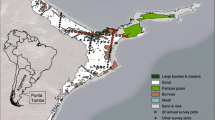Abstract
We investigated population size, nest success, and nest-site characteristics of Saltmarsh Sharptailed Sparrows (Ammodramus caudacutus) from 1993 to 1998 in a salt marsh near Galilee, Rhode Island. From 1956 to 1997, tidal flow was restricted in the marsh by construction of a road with small culverts, which resulted in conversion of the marsh from short- and tall-form cordgrass (Spartina alterniflora) and marsh hay (S. patens) to one dominated by >5 m tall common reed (Phragmites australis). In fall 1997, self-regulating tide gates were installed to restore the historic tidal regime and vegetation. We documented declines in adult sparrow population sizes (17–25% annual decline) and productivity (48% annual decline) while the tidal regime was restricted. Nest success was variable (10–83%) before 1998, with predators accounting for most nest losses. Saltmarsh Sharp-tailed Sparrows usually nested in marsh hay, short-form cordgrass, and short common reed. After restoration, sparrows nested where vegetation was taller, which permitted greater nest elevation. However, 91% of nests failed due to flooding following installation of new tide gates. We hypothesize that restoration efforts will have short-term negative impacts on Saltmarsh Sharptailed Sparrow populations until salt marsh habitats are restored in higher sections of the marsh.
Similar content being viewed by others
Literature Cited
Bart, J. and D. S. Robson. 1982. Estimating survivorship when the subjects are visited periodically. Ecology 63:1078–1090.
Benoit, L. K. and R. A. Askins. 1999. Impact of the spread of Phragmites on the distribution of birds in Connecticut tidal marshes. Wetlands 19:194–208.
Brawley, A. H., R. S. Warren, and R. A. Askins. 1998. Bird use of restoration and reference marshes within the Barn Island Wildlife Management Area, Stonington, Connecticut, USA. Environmental Management 22:625–633.
Caughley, G. and A. Gunn. 1996. Conservation Biology in Theory and Practice. Blackwell Science Inc., Cambridge, MA, USA.
DeRagon, W. R. 1988. Breeding ecology of Seaside and Sharp-tailed Sparrows in Rhode Island salt marshes. M.S. Thesis. University of Rhode Island, Kingston, RI, USA.
DiQuinzio, D. A. 1999. Population and breeding ecology of the promiscuous Saltmarsh Sharp-tailed Sparrow in Rhode Island salt marshes. M.S. Thesis. University of Rhode Island, Kingston, RI, USA.
DiQuinzio, D. A., P. W. C. Paton, and W. R. Eddleman. 2001. Site fidelity, philopatry, and survival of promiscuous Saltmarsh Sharptailed Sparrows in Rhode Island. Auk 118:888–899.
Greenlaw, J. S. and J. D. Rising. 1994. Sharp-tailed Sparrow (Ammodramus caudacutus). p. 1–28 In A. Poole and F. Gill (eds.) The Birds of North America, No. 112. Academy of Natural Sciences, Philadelphia, PA, USA.
Hines, J. E. 1999. Program MAYFIELD. Patuxent Wildlife Research Center, Laurel, MD, USA.
Mayfield, H. 1961. Nesting success calculated from exposure. Wilson Bulletin 73:255–261.
Mayfield, H. 1961. Nesting success calculated from exposure. Wilson Bulletin 73:255–261.
Myshrall, D. H. A. 1996. Influence of tidal hydrology on the distribution and structure of salt marsh plant communities at the Galilee Bird Sanctuary, Narragansett, Rhode Island. M.S. Thesis. University of Rhode Island, Kingston, RI, USA.
Myshrall, D. H. A., F. C. Golet, P. W. C. Paton, and B. C. Tefft. 2000. Salt marsh restoration monitoring at the Galilee Bird Sanctuary, Narragansett, R.I. Final Report, Rhode Island Department of Environmental Management, Division of Fish and Wildlife, Federal Aid in Wildlife Restoration, Rhode Island Avian Studies, Jobs 17–19, West Kingston, RI, USA.
Post, W. and J. S. Greenlaw. 1982. Comparative costs of promiscuity and monogamy: a test of reproductive effort theory. Behavioral Ecology and Sociobiology 10:101–107.
Reinert, S. E., F. C. Golet, and W. R. DeRagon. 1981. Avian use of ditched and unditched salt marshes in southeastern New England: a preliminary report. 27th Annual Meeting of the Northeast Mosquito Control Association, Newport, RI, USA.
Sinicrope, T. L., P. G. Hine, R. S. Warren, and W. A. Niering. 1990. Restoration of an impounded salt marsh in New England. Estuaries 13:25–30.
Slavin, P. and J. K. Shisler. 1983. Avian utilization of a tidally restored salt hay farm. Biological Conservation 26:271–285.
SPSS, Inc. 1998. SPSS Base 8.0 Applications Guide. SPSS Inc., Chicago, IL. USA.
Author information
Authors and Affiliations
Corresponding author
Rights and permissions
About this article
Cite this article
DiQuinzio, D.A., Paton, P.W.C. & Eddleman, W.R. Nesting ecology of Saltmarsh Sharp-tailed Sparrows in a tidally restricted salt marsh. Wetlands 22, 179–185 (2002). https://doi.org/10.1672/0277-5212(2002)022[0179:NEOSST]2.0.CO;2
Received:
Revised:
Accepted:
Issue Date:
DOI: https://doi.org/10.1672/0277-5212(2002)022[0179:NEOSST]2.0.CO;2




